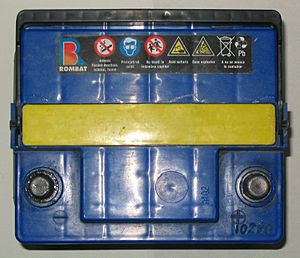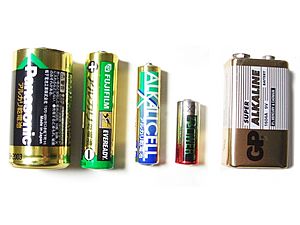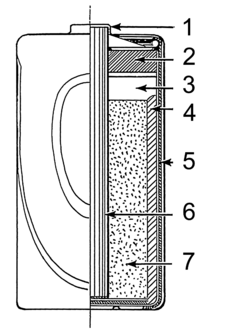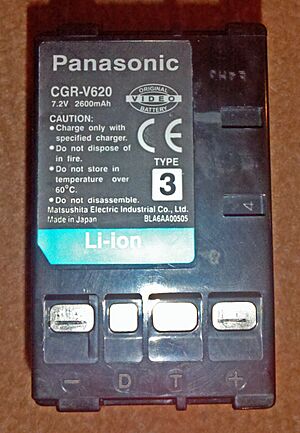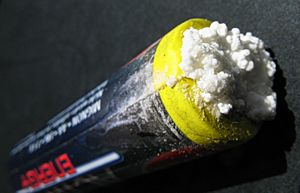Battery facts for kids
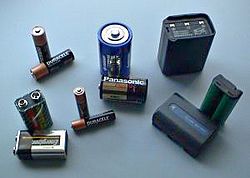
|
|
| Type | Power source |
|---|---|
| Working principle | Electrochemical reactions, Electromotive force |
| First production | 1800s |
| Electronic symbol | |
 The symbol for a battery in a circuit diagram. It originated as a schematic drawing of the earliest type of battery, a voltaic pile. |
|
A battery is a device that can store electricity. Some are rechargeable, and some are not. They store direct current (DC) electricity.
A battery really means two or more wet or dry cells connected in series for more voltage, or in parallel for more current, although people often call a cell a battery. AA, AAA, C, and D batteries all have 1.5 volts. The voltage of a cell depends on the chemicals used while the amount of power or current it can supply also depends on how large the cell is; a bigger cell of a given type can supply more amps, or for a longer time.
The chemical reactions that occur in a battery are exothermic reactions and, thus, produce heat. For example, if you leave your laptop on for a long time, and then touch the battery, it will be warm or hot. However, the batteries used in laptops are called Lithium batteries and they do have a fire hazard (A few years ago, dell laptops that that were powered by lithium batteries began to catch fire, though this event was rare.).
Batteries come in lots of different shapes and sizes and voltages. It is possible, but not easy, to run wires to use an odd size battery for an odd purpose.
Batteries are always more costly/expensive than mains electricity. But mains electricity is not suitable for things that are mobile.
Bicycles have tail-lights that can be operated by batteries, and sometimes by a little generator powered by the wheels.
Hand and foot generators can be used to replace batteries, but they can be tiresome.
Wind-up generators are now available to power small clockwork radios, clockwork torches, etc.
Since clockwork clocks have been around for hundreds of years, and batteries for two hundred, it is amazing that no-one thought of a clockwork torch until recently.
Rechargeable batteries are recharged by reversing the chemical reaction that occurs within the battery. Although, a rechargeable battery can only be recharged a given amount of time (recharge life). Even iPods, with built in batteries, cannot be recharged forever. Moreover, each time you recharge a battery, its ability to hold a charge is degraded a bit. Never attempt to recharge a non-rechargeable battery, the battery acids inside will most likely leak out.
Contents
History
The very first batteries were invented in the middle east around 1000 B.C.
The first battery was invented in 1800 by Alessandro Volta. Nowadays, his battery is called the voltaic pile.
Later batteries were bottles with a fluid and some metal rods in them. People had to be careful not to turn these batteries upside-down so the fluid would spill.
In modern batteries, the fluid is "soaked up" in a kind of paste. And everything is put in a completely tight case: Because of this case, nothing can spill out of the battery.
Battery sizes
Batteries come in many different shapes, sizes and voltages.
AA, AAA, C, and D cells, including alkaline batteries, are of standard sizes and shapes, and have about 1.5 volts. The voltage of a cell depends on the chemicals used. The electric charge it can supply depends on how large the cell is, as well as what chemicals. The charge a battery delivers is usually measured in ampere-hours. Since the voltage stays the same, more charge means a bigger cell can supply more amps, or run for a longer time.
Types
Primary and secondary batteries
Batteries are classified into primary and secondary forms:
- Primary batteries are designed to be used until exhausted of energy then discarded. Their chemical reactions are generally not reversible, so they cannot be recharged. When the supply of reactants in the battery is exhausted, the battery stops producing current and is useless.
- Secondary batteries can be recharged; that is, they can have their chemical reactions reversed by applying electric current to the cell. This regenerates the original chemical reactants, so they can be used, recharged, and used again multiple times.
Some types of primary batteries used, for example, for telegraph circuits, were restored to operation by replacing the electrodes. Secondary batteries are not indefinitely rechargeable due to dissipation of the active materials, loss of electrolyte and internal corrosion.
Primary batteries, or primary cells, can produce current immediately on assembly. These are most commonly used in portable devices that have low current drain, are used only intermittently, or are used well away from an alternative power source, such as in alarm and communication circuits where other electric power is only intermittently available. Disposable primary cells cannot be reliably recharged, since the chemical reactions are not easily reversible and active materials may not return to their original forms. Battery manufacturers recommend against attempting to recharge primary cells. In general, these have higher energy densities than rechargeable batteries, but disposable batteries do not fare well under high-drain applications with loads under 75 ohms (75 Ω). Common types of disposable batteries include zinc–carbon batteries and alkaline batteries.
Secondary batteries, also known as secondary cells, or rechargeable batteries, must be charged before first use; they are usually assembled with active materials in the discharged state. Rechargeable batteries are (re)charged by applying electric current, which reverses the chemical reactions that occur during discharge/use. Devices to supply the appropriate current are called chargers. The oldest form of rechargeable battery is the lead–acid battery, which are widely used in automotive and boating applications. This technology contains liquid electrolyte in an unsealed container, requiring that the battery be kept upright and the area be well ventilated to ensure safe dispersal of the hydrogen gas it produces during overcharging. The lead–acid battery is relatively heavy for the amount of electrical energy it can supply. Its low manufacturing cost and its high surge current levels make it common where its capacity (over approximately 10 Ah) is more important than weight and handling issues. A common application is the modern car battery, which can, in general, deliver a peak current of 450 amperes.
Composition
Many types of electrochemical cells have been produced, with varying chemical processes and designs, including galvanic cells, electrolytic cells, fuel cells, flow cells and voltaic piles.
A wet cell battery has a liquid electrolyte. Other names are flooded cell, since the liquid covers all internal parts or vented cell, since gases produced during operation can escape to the air. Wet cells were a precursor to dry cells and are commonly used as a learning tool for electrochemistry. They can be built with common laboratory supplies, such as beakers, for demonstrations of how electrochemical cells work. A particular type of wet cell known as a concentration cell is important in understanding corrosion. Wet cells may be primary cells (non-rechargeable) or secondary cells (rechargeable). Originally, all practical primary batteries such as the Daniell cell were built as open-top glass jar wet cells. Other primary wet cells are the Leclanche cell, Grove cell, Bunsen cell, Chromic acid cell, Clark cell, and Weston cell. The Leclanche cell chemistry was adapted to the first dry cells. Wet cells are still used in automobile batteries and in industry for standby power for switchgear, telecommunication or large uninterruptible power supplies, but in many places batteries with gel cells have been used instead. These applications commonly use lead–acid or nickel–cadmium cells. Molten salt batteries are primary or secondary batteries that use a molten salt as electrolyte. They operate at high temperatures and must be well insulated to retain heat.
A dry cell uses a paste electrolyte, with only enough moisture to allow current to flow. Unlike a wet cell, a dry cell can operate in any orientation without spilling, as it contains no free liquid, making it suitable for portable equipment. By comparison, the first wet cells were typically fragile glass containers with lead rods hanging from the open top and needed careful handling to avoid spillage. Lead–acid batteries did not achieve the safety and portability of the dry cell until the development of the gel battery. A common dry cell is the zinc–carbon battery, sometimes called the dry Leclanché cell, with a nominal voltage of 1.5 volts, the same as the alkaline battery (since both use the same zinc–manganese dioxide combination). A standard dry cell comprises a zinc anode, usually in the form of a cylindrical pot, with a carbon cathode in the form of a central rod. The electrolyte is ammonium chloride in the form of a paste next to the zinc anode. The remaining space between the electrolyte and carbon cathode is taken up by a second paste consisting of ammonium chloride and manganese dioxide, the latter acting as a depolariser. In some designs, the ammonium chloride is replaced by zinc chloride.
A reserve battery can be stored unassembled (unactivated and supplying no power) for a long period (perhaps years). When the battery is needed, then it is assembled (e.g., by adding electrolyte); once assembled, the battery is charged and ready to work. For example, a battery for an electronic artillery fuze might be activated by the impact of firing a gun. The acceleration breaks a capsule of electrolyte that activates the battery and powers the fuze's circuits. Reserve batteries are usually designed for a short service life (seconds or minutes) after long storage (years). A water-activated battery for oceanographic instruments or military applications becomes activated on immersion in water.
On 28 February 2017, the University of Texas at Austin issued a press release about a new type of solid-state battery, developed by a team led by lithium-ion battery inventor John Goodenough, "that could lead to safer, faster-charging, longer-lasting rechargeable batteries for handheld mobile devices, electric cars and stationary energy storage". The solid-state battery is also said to have "three times the energy density", increasing its useful life in electric vehicles, for example. It should also be more ecologically sound since the technology uses less expensive, earth-friendly materials such as sodium extracted from seawater. They also have much longer life.
Sony has developed a biological battery that generates electricity from sugar in a way that is similar to the processes observed in living organisms. The battery generates electricity through the use of enzymes that break down carbohydrates.
The sealed valve regulated lead–acid battery (VRLA battery) is popular in the automotive industry as a replacement for the lead–acid wet cell. The VRLA battery uses an immobilized sulfuric acid electrolyte, reducing the chance of leakage and extending shelf life. VRLA batteries immobilize the electrolyte. The two types are:
- Gel batteries (or "gel cell") use a semi-solid electrolyte.
- Absorbed Glass Mat (AGM) batteries absorb the electrolyte in a special fiberglass matting.
Other portable rechargeable batteries include several sealed "dry cell" types, that are useful in applications such as mobile phones and laptop computers. Cells of this type (in order of increasing power density and cost) include nickel–cadmium (NiCd), nickel–zinc (NiZn), nickel metal hydride (NiMH), and lithium-ion (Li-ion) cells. Li-ion has by far the highest share of the dry cell rechargeable market. NiMH has replaced NiCd in most applications due to its higher capacity, but NiCd remains in use in power tools, two-way radios, and medical equipment.
In the 2000s, developments include batteries with embedded electronics such as USBCELL, which allows charging an AA battery through a USB connector, nanoball batteries that allow for a discharge rate about 100x greater than current batteries, and smart battery packs with state-of-charge monitors and battery protection circuits that prevent damage on over-discharge. Low self-discharge (LSD) allows secondary cells to be charged prior to shipping.
Lithium–sulfur batteries were used on the longest and highest solar-powered flight.
Consumer and industrial grades
Batteries of all types are manufactured in consumer and industrial grades. Costlier industrial-grade batteries may use chemistries that provide higher power-to-size ratio, have lower self-discharge and hence longer life when not in use, more resistance to leakage and, for example, ability to handle the high temperature and humidity associated with medical autoclave sterilization.
Combination and management
Standard-format batteries are inserted into battery holder in the device that uses them. When a device does not uses standard-format batteries, they are typically combined into a custom battery pack which holds multiple batteries in addition to features such as a battery management system and battery isolator which ensure that the batteries within are charged and discharged evenly.
Lifespan
Battery life (and its synonym battery lifetime) has two meanings for rechargeable batteries but only one for non-chargeables. For rechargeables, it can mean either the length of time a device can run on a fully charged battery or the number of charge/discharge cycles possible before the cells fail to operate satisfactorily. For a non-rechargeable these two lives are equal since the cells last for only one cycle by definition. The term shelf life is used to describe how long a battery will retain its performance between manufacture and use. Available capacity of all batteries drops with decreasing temperature. In contrast to most of today's batteries, the Zamboni pile, invented in 1812, offers a very long service life without refurbishment or recharge, although it supplies current only in the nanoamp range. The Oxford Electric Bell has been ringing almost continuously since 1840 on its original pair of batteries, thought to be Zamboni piles.
Disposable batteries typically lose 8–20% of their original charge per year when stored at room temperature (20–30 °C). This is known as the "self-discharge" rate, and is due to non-current-producing "side" chemical reactions that occur within the cell even when no load is applied. The rate of side reactions is reduced for batteries stored at lower temperatures, although some can be damaged by freezing. Old rechargeable batteries self-discharge more rapidly than disposable alkaline batteries, especially nickel-based batteries; a freshly charged nickel cadmium (NiCd) battery loses 10% of its charge in the first 24 hours, and thereafter discharges at a rate of about 10% a month. However, newer low self-discharge nickel metal hydride (NiMH) batteries and modern lithium designs display a lower self-discharge rate (but still higher than for primary batteries).
The active material on the battery plates changes chemical composition on each charge and discharge cycle; active material may be lost due to physical changes of volume, further limiting the number of times the battery can be recharged. Most nickel-based batteries are partially discharged when purchased, and must be charged before first use. Newer NiMH batteries are ready to be used when purchased, and have only 15% discharge in a year.
Some deterioration occurs on each charge–discharge cycle. Degradation usually occurs because electrolyte migrates away from the electrodes or because active material detaches from the electrodes. Low-capacity NiMH batteries (1,700–2,000 mA·h) can be charged some 1,000 times, whereas high-capacity NiMH batteries (above 2,500 mA·h) last about 500 cycles. NiCd batteries tend to be rated for 1,000 cycles before their internal resistance permanently increases beyond usable values. Fast charging increases component changes, shortening battery lifespan. If a charger cannot detect when the battery is fully charged then overcharging is likely, damaging it.
NiCd cells, if used in a particular repetitive manner, may show a decrease in capacity called "memory effect". The effect can be avoided with simple practices. NiMH cells, although similar in chemistry, suffer less from memory effect.
Automotive lead–acid rechargeable batteries must endure stress due to vibration, shock, and temperature range. Because of these stresses and sulfation of their lead plates, few automotive batteries last beyond six years of regular use. Automotive starting (SLI: Starting, Lighting, Ignition) batteries have many thin plates to maximize current. In general, the thicker the plates the longer the life. They are typically discharged only slightly before recharge. "Deep-cycle" lead–acid batteries such as those used in electric golf carts have much thicker plates to extend longevity. The main benefit of the lead–acid battery is its low cost; its main drawbacks are large size and weight for a given capacity and voltage. Lead–acid batteries should never be discharged to below 20% of their capacity, because internal resistance will cause heat and damage when they are recharged. Deep-cycle lead–acid systems often use a low-charge warning light or a low-charge power cut-off switch to prevent the type of damage that will shorten the battery's life.
Battery life can be extended by storing the batteries at a low temperature, as in a refrigerator or freezer, which slows the side reactions. Such storage can extend the life of alkaline batteries by about 5%; rechargeable batteries can hold their charge much longer, depending upon type. To reach their maximum voltage, batteries must be returned to room temperature; discharging an alkaline battery at 250 mA at 0 °C is only half as efficient as at 20 °C. Alkaline battery manufacturers such as Duracell do not recommend refrigerating batteries.
Hazards
A battery explosion is generally caused by misuse or malfunction, such as attempting to recharge a primary (non-rechargeable) battery, or a short circuit.
When a battery is recharged at an excessive rate, an explosive gas mixture of hydrogen and oxygen may be produced faster than it can escape from within the battery (e.g. through a built-in vent), leading to pressure build-up and eventual bursting of the battery case. In extreme cases, battery chemicals may spray violently from the casing and cause injury. An expert summary of the problem indicates that this type uses "liquid electrolytes to transport lithium ions between the anode and the cathode. If a battery cell is charged too quickly, it can cause a short circuit, leading to explosions and fires". Car batteries are most likely to explode when a short circuit generates very large currents. Such batteries produce hydrogen, which is very explosive, when they are overcharged (because of electrolysis of the water in the electrolyte). During normal use, the amount of overcharging is usually very small and generates little hydrogen, which dissipates quickly. However, when "jump starting" a car, the high current can cause the rapid release of large volumes of hydrogen, which can be ignited explosively by a nearby spark, e.g. when disconnecting a jumper cable.
Overcharging (attempting to charge a battery beyond its electrical capacity) can also lead to a battery explosion, in addition to leakage or irreversible damage. It may also cause damage to the charger or device in which the overcharged battery is later used.
Disposing of a battery via incineration may cause an explosion as steam builds up within the sealed case.
Many battery chemicals are corrosive, poisonous or both. If leakage occurs, either spontaneously or through accident, the chemicals released may be dangerous. For example, disposable batteries often use a zinc "can" both as a reactant and as the container to hold the other reagents. If this kind of battery is over-discharged, the reagents can emerge through the cardboard and plastic that form the remainder of the container. The active chemical leakage can then damage or disable the equipment that the batteries power. For this reason, many electronic device manufacturers recommend removing the batteries from devices that will not be used for extended periods of time.
Many types of batteries employ toxic materials such as lead, mercury, and cadmium as an electrode or electrolyte. When each battery reaches end of life it must be disposed of to prevent environmental damage. Batteries are one form of electronic waste (e-waste). E-waste recycling services recover toxic substances, which can then be used for new batteries. Of the nearly three billion batteries purchased annually in the United States, about 179,000 tons end up in landfills across the country.
Batteries may be harmful or fatal if swallowed. Small button cells can be swallowed, in particular by young children. While in the digestive tract, the battery's electrical discharge may lead to tissue damage; such damage is occasionally serious and can lead to death. Ingested disk batteries do not usually cause problems unless they become lodged in the gastrointestinal tract. The most common place for disk batteries to become lodged is the esophagus, resulting in clinical sequelae. Batteries that successfully traverse the esophagus are unlikely to lodge elsewhere. The likelihood that a disk battery will lodge in the esophagus is a function of the patient's age and battery size. Older children do not have problems with batteries smaller than 21–23 mm. Liquefaction necrosis may occur because sodium hydroxide is generated by the current produced by the battery (usually at the anode). Perforation has occurred as rapidly as 6 hours after ingestion.
Some battery manufactures have added a bad taste to batteries to discourage swallowing.
Future
Between 2010 and 2018, annual battery demand grew by 30%, reaching a total of 180 GWh in 2018. Conservatively, the growth rate is expected to be maintained at an estimated 25%, culminating in demand reaching 2600 GWh in 2030. In addition, cost reductions are expected to further increase the demand to as much as 3562 GWh.
Important reasons for this high rate of growth of the electric battery industry include the electrification of transport, and large-scale deployment in electricity grids, supported by anthropogenic climate change-driven moves away from fossil-fuel combusted energy sources to cleaner, renewable sources, and more stringent emission regimes.
Distributed electric batteries, such as those used in battery electric vehicles (vehicle-to-grid), and in home energy storage, with smart metering and that are connected to smart grids for demand response, are active participants in smart power supply grids. New methods of reuse, such as echelon use of partly-used batteries, add to the overall utility of electric batteries, reduce energy storage costs, and also reduce pollution/emission impacts due to longer lives. In echelon use of batteries, vehicle electric batteries that have their battery capacity reduced to less than 80%, usually after service of 5–8 years, are repurposed for use as backup supply or for renewable energy storage systems.
Grid scale energy storage envisages the large-scale use of batteries to collect and store energy from the grid or a power plant and then discharge that energy at a later time to provide electricity or other grid services when needed. Grid scale energy storage (either turnkey or distributed) are important components of smart power supply grids.
Comparison
Many important cell properties, such as voltage, energy density, flammability, available cell constructions, operating temperature range and shelf life, are dictated by battery chemistry.
| Chemistry | Anode (−) | Cathode (+) | Max. voltage, theoretical (V) | Nominal voltage, practical (V) | Specific energy (kJ/kg) | Elaboration | Shelf life at 25 °C, 80% capacity (months) |
|---|---|---|---|---|---|---|---|
| Zinc–carbon | Zn | C | 1.6 | 1.2 | 130 | Inexpensive. | 18 |
| Zinc–chloride | Zn | C | 1.5 | Also known as "heavy-duty", inexpensive. | |||
| Alkaline (zinc–manganese dioxide) | Zn | MnO2 | 1.5 | 1.15 | 400-590 | Moderate energy density. Good for high- and low-drain uses. | 30 |
| Nickel oxyhydroxide (zinc–manganese dioxide/nickel oxyhydroxide) | 1.7 | Moderate energy density. Good for high drain uses. | |||||
| Lithium (lithium–copper oxide) Li–CuO | Li | CuO | 1.7 | No longer manufactured. Replaced by silver oxide (IEC-type "SR") batteries. | |||
| Lithium (lithium–iron disulfide) LiFeS2 | Li | FeS2 | 1.8 | 1.5 | 1070 | Expensive. Used in 'plus' or 'extra' batteries. | 337 |
| Lithium (lithium–manganese dioxide) LiMnO2 | Li | MnO2 | 3.0 | 830–1010 | Expensive. Used only in high-drain devices or for long shelf-life due to very low rate of self-discharge. 'Lithium' alone usually refers to this type of chemistry. | ||
| Lithium (lithium–carbon fluoride) Li–(CF)n | Li | (CF)n | 3.6 | 3.0 | 120 | ||
| Lithium (lithium–chromium oxide) Li–CrO2 | Li | CrO2 | 3.8 | 3.0 | 108 | ||
| Lithium (lithium-silicon) | Li22Si5 | ||||||
| Mercury oxide | Zn | HgO | 1.34 | 1.2 | High-drain and constant voltage. Banned in most countries because of health concerns. | 36 | |
| Zinc–air | Zn | O2 | 1.6 | 1.1 | 1590 | Used mostly in hearing aids. | |
| Zamboni pile | Zn | Ag or Au | 0.8 | Very long life. Very low (nanoamp, nA) current | >2,000 | ||
| Silver oxide (silver–zinc) | Zn | Ag2O | 1.85 | 1.5 | 470 | Very expensive. Used only commercially in 'button' cells. | 30 |
| Magnesium | Mg | MnO2 | 2.0 | 1.5 | 40 |
| Chemistry | Cell voltage | Specific energy (kJ/kg) | Energy density (kJ/liter) | Comments |
|---|---|---|---|---|
| NiCd | 1.2 | 140 | Inexpensive. High-/low-drain, moderate energy density. Can withstand very high discharge rates with virtually no loss of capacity. Moderate rate of self-discharge. Environmental hazard due to Cadmium, use now virtually prohibited in Europe. | |
| Lead–acid | 2.1 | 140 | Moderately expensive. Moderate energy density. Moderate rate of self-discharge. Higher discharge rates result in considerable loss of capacity. Environmental hazard due to Lead. Common use: automobile batteries | |
| NiMH | 1.2 | 360 | Inexpensive. Performs better than alkaline batteries in higher drain devices. Traditional chemistry has high energy density, but also a high rate of self-discharge. Newer chemistry has low self-discharge rate, but also a ~25% lower energy density. Used in some cars. |
|
| NiZn | 1.6 | 360 | Moderately inexpensive. High drain device suitable. Low self-discharge rate. Voltage closer to alkaline primary cells than other secondary cells. No toxic components. Newly introduced to the market (2009). Has not yet established a track record. Limited size availability. | |
| AgZn | 1.86 1.5 | 460 | Smaller volume than equivalent Li-ion. Extremely expensive due to silver. Very high energy density. Very high drain capable. For many years considered obsolete due to high silver prices. Cell suffers from oxidation if unused. Reactions are not fully understood. Terminal voltage very stable but suddenly drops to 1.5 volts at 70–80% charge (believed to be due to presence of both argentous and argentic oxide in positive plate; one is consumed first). Has been used in lieu of primary battery (moon buggy). Is being developed once again as a replacement for Li-ion. | |
| LiFePO4 | 3.3 3.0 | 360 | 790 | Lithium-Iron-Phosphate chemistry. |
| Lithium ion | 3.6 | 460 | Very expensive. Very high energy density. Not usually available in "common" battery sizes. Lithium polymer battery is common in laptop computers, digital cameras, camcorders, and cellphones. Very low rate of self-discharge. Terminal voltage varies from 4.2 to 3.0 volts during discharge. Volatile: Chance of explosion if short-circuited, allowed to overheat, or not manufactured with rigorous quality standards. |



